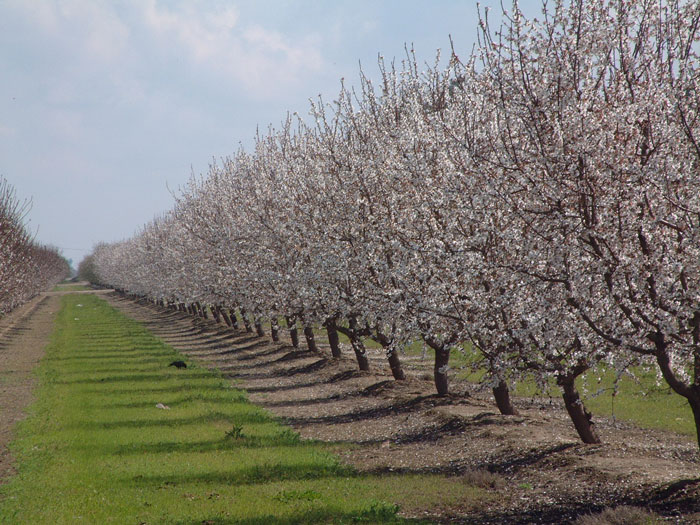
Warm weather jump starts Merced County almond season
“As long as bloom density is high, there’s no need to be too concerned about the earlier pushing of leaves. However, the appearance of more leaves than normal without many floral buds could indicate the likelihood of lower yields.”
March 4, 2016

Warmer-than-usual temperatures in late January pushed the 2016 almond season off to an early fast start for Merced County growers – a little earlier even than last year’s unusually early start.
“Temperatures farther south in the San Joaquin Valley have been about normal so far this year, says David Doll, University of California Cooperative Extension pomology farm advisor for Merced County.
“But they’ve been substantially warmer here which has accelerated the bloom.”
The first flowers opened in the southern part of the county around Feb. 8, Doll reports. Within 12 days, most Nonpareil and their pollinator varieties were in full bloom. By then, about 10-20 percent of the Butte-Padre and other hard shell varieties began to bloom.
“The bloom has been relatively strong and should wrap up by the first of March,” he says.
This would be about 10-14 days earlier than normal, increasing the risk of frost damage, which can extend in this area until early April, Doll notes.
Normally, vegetative buds begin pushing later than floral buds. This year, however, bud push of the two types coincided.
“As long as bloom density is high, there’s no need to be too concerned about the earlier pushing of leaves,” Doll says. “However, the appearance of more leaves than normal without many floral buds could indicate the likelihood of lower yields.”
On the other hand, adequate winter chilling hours bode well for the new season. So does the ability of most growers to irrigate orchards sufficiently last fall after harvest to help prevent early leaf drop.
“In most orchards, the trees retained leaves long enough for photosynthesis to continue and provide energy reserves for this year’s crop, Doll says.
Rains this winter helped provide moisture for most Merced County almond orchards to a depth of about five feet, except for heavier soils where moisture extends no lower than about four feet below the soil surface, he notes.
Meanwhile, uncertainties about any remaining impact of the El Niño weather pattern on water supplies and strong doubts about possible deliveries of surface water are high on the mind of growers as they assess their 2016 production prospects.
“Generally, growers expect yields will be similar to last year,” Doll says. “A lot of new blocks of trees will be coming into production which will help compensate for older blocks being removed.
However, a real wet spring could increase disease threat and hurt production.
Excess soil salinity levels remain a concern in some Merced County orchards, he adds. Ideally, growers would have been able to irrigate during dormancy to flush salts below the root zone.
With water in short supply, this may not have been possible for some growers. In that case, Doll recommends using surface water, if available, for in-season leaching.
“Depending on the quality of the water and salt levels in the soil, this may require applying about 10-30 percent more water than normal with each irrigation.”
For growers who fertigate, Doll advises to hold off nitrogen applications in irrigation water until leaves fully expand and begin to pull water. Otherwise, growers can risk harmful water saturation of the root zone.
“Usually, you don’t need to rush the first irrigation of the season to feed nitrogen since the trees should have ample levels of the nutrient in reserve,” Doll says.
“Until the leaves start pulling water they don’t remove much water or nitrogen from the root zone. Applying too much water before then can saturate the root-zone and create anaerobic conditions that can hurt the tree.”
You May Also Like



